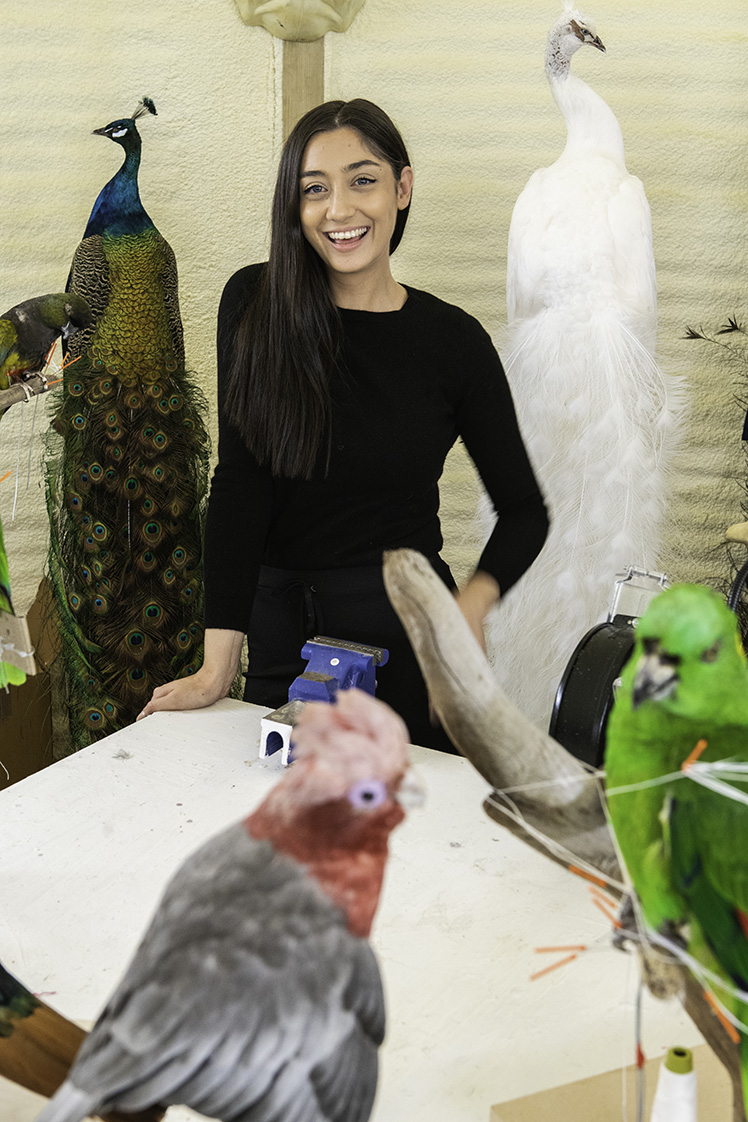In our autumn issue, we spoke to five women working with death in some way. Death needn’t be mysterious, these five women told us about their day-to-day reality and why it’s so important to talk about dying and grief. This is an extract from the feature, Elle Kaye tells us about her life as a taxidermist.

Portrait by James Stittle
Elle Kaye, taxidermist
I didn’t grow up surrounded by taxidermy. I didn’t even know it could be a career. I grew up wanting to be a vet. I loved animals, but not in your typical, ‘oh that’s so cute and fluffy’ way. In a way where I felt compelled to be a part of their life, aiding them or nurturing them in some way. After some heartache in the sciences, I ended up studying fine art and sculpture. In a quest to include animals in my practice, someone suggested I try taxidermy. I was already looking at anatomical illustrations. The harmony of science, anatomy and preservation and artistry, sculptural accuracy and model making within taxidermy, places it in both an artistic, and scientific context. Being able to use the skins in this way, presented a platform for me to learn about animals, and to teach others about them, too.
Knowing that the work I create will outlive me is a rewarding concept. It gives me a huge sense of pride and will be my legacy. I administer a dual preservative, essentially preserving the skins with two complementary techniques, so when I go to bed at night, I know the animals will be okay. This isn’t particularly textbook, and certainly not a necessity, but is more of an assurance to me.
I realise that I am operating in a sensitive sphere, with the addition that it is not a ‘commonplace’ job, so I do appreciate people may make incorrect assumptions about what I do. I experience a lot of ‘hate’. But, to devote your professional life to working with animals, recreating them for education and appreciation – you must love animals to do that. I could never kill an animal myself.
I source all the animals I use, that way I can ensure they have been obtained legally and lawfully, are in a good condition, and aren’t carrying any transferable diseases. I receive my specimens from zoos, aviaries, sanctuaries, ornamental breeders, falconries, and farms. It’s important to me that the animals die of natural causes. It’s also essential that paperwork is provided with the specimen, so I can see the cause of death and log the specimen correctly.
A typical day for me, sees me get in to the workshop early in the morning. I’m on a farm, and the landscape is beautiful, especially in the autumn with crisp mornings and coloured trees. I store all the specimens carefully in big freezers, to prevent them from decomposing, so I will take an animal out to thaw overnight and spend the next morning skinning and cleaning it. This might involve de-fatting, on a machine, or using a beam to thin and remove the membrane on the inside of the skin. This then gets soaked, in a chronological set of baths. Either salting and pickling for mammals, or alcohol and chemical baths for birds. This is followed up with bubble baths and blow dries! Specimen dependent, I can re-freeze the skin, and spend the afternoon mounting a cleaned, thawed skin. When the animals are dry, they need airbrushing and fumigating, so this element is interweaved amongst the others. Typically, I have lots of different projects on the go. Sometimes I work off site, retrieving animals from locations across the country.
If I could work on any specimen in the world it would be a whale – they’re my favourite animals. This would be an extremely unusual case, due to their size and lack of captivity. But, it has been done before, in Sweden.
Nothing ‘grosses’ me out. I expect animals to have flaws and defects, just like humans. Sometimes, there are eggs still in birds, or trauma inside an animal. Prolapses, or blood clots, or shattered bone due to window death or impact.
Meet the four other women in our autumn issue.
